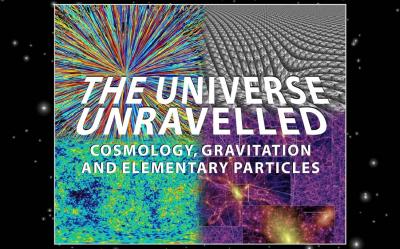What are we? Where do we come from? Where are we going? In the language of physics, these become: What is the structure of matter? How did the Universe evolve? How will it evolve in the future? John Wheeler's famous mantra, IT from BIT, envisaged the Universe as an information structure of BITs. And, of course, so IT is, fundamentally quantum and statistical, the manypaths/ many-worlds story with our Universe expanding from a initial hot dense state. This idea of an expanding Universe grew out of observations of the motions of the galaxies around us, and a series of discoveries turned the idea of expansion into a convincingly demonstrated aspect of reality. A notable piece of the evidence of this hot big bang is the fossil thermal radiation left from the past. There is an intimate entanglement of theory with precision ‘first-light’ and other cosmic data. Examination of the properties of this radiation, and of the galaxies and the nature of space-time around them, shows that the expansion is well described by Einstein's theory of gravity, general relativity. This theory tells us that there is a warped side to our Universe: objects and phenomena that are made from warped space and warped time. Three examples are black holes, the big-bang in which our Universe was born, and ripples in the fabric of spacetime called gravitational waves.
In this public event, the four eminent speakers will unravel the fascinating story of our Universe and broaden the enquiry into the vast sweep of ideas about the nature of our Universe. Some details about each of these lectures and the lecturers can be accessed by clicking on the four images below.
KIP S. THORNE
The Warped Side of our Universe: From the Big Bang to Black Holes and Gravitational Waves
There is a Warped Side to our Universe: objects and phenomena that are made from warped space and warped time. Three examples are black holes, the big-bang in which our Universe was born, and ripples in the fabric of space-time called gravitational waves. Thorne will describe the Warped Side of our Universe and the quest to probe it theoretically using computer simulations, and observationally using gravitational waves.
J. RICHARD BOND
Cosmic Information Theory and Analysis: IT from BIT, from BITs in IT
John Wheeler's famous mantra, IT from BIT, envisaged the Universe as an information structure of BITs. And, of course, so IT is, fundamentally quantum and statistical, the many-paths/many-worlds information-theoretic story. This lecture uses Cosmic Information Theory and Analysis, CITA, as a unifying theme to explore the vast sweep of our current ideas of the Universe and the experiments we use to probe them, ranging from the ultra-early beginnings to our far-future fate. I describe the intimate entanglement of theory with precision "first-light" and other cosmic data, in particular from the cosmic microwave background satellite Planck and the Andes-based Atacama Cosmology Telescope. Such data are the BITs in IT informing us of the physics that defines the BIT of the Universe accessible to us from which we hope to learn of that vast IT which encodes all Cosmic Information.
P JAMES PEEBLES
Discoversing the large scale Nature of the Physical Universe
Our universe expanded from a hot dense state. The idea of an expanding universe grew out of observations of the motions of the galaxies of stars around us, and a series of discoveries turned the idea of expansion into a convincingly demonstrated aspect of reality. A notable piece of the evidence of this hot big bang is the fossil thermal radiation left from a time when the universe had to have been very different from now, hot and dense. Examination of the properties of this radiation, and of the galaxies and the warps of spacetime around them, shows that the expansion is well described by Einstein's theory of gravity, general relativity. Many open questions remain for ongoing research, of course. A few questions will be mentioned, and Dick Bond will the broaden the enquiry into the vast sweep of ideas about the nature of our universe.
JOHN ELLIS
Answering Gauguin's questions with the Large Hadron Collider
In a famous painting, Gauguin showed people asking 3 basic questions: what are we? where do we come from? where are we going? In the language of physics, these become: what is the structure of matter? how did the Universe evolve? how will it evolve in the future? Experiments at the Large Hadron Collider are addressing these questions, and this talk will review the prospects for finding answers.


